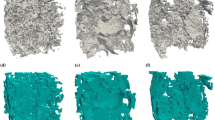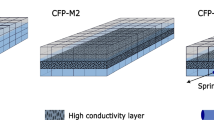Abstract.
The influence of aquifer property correlation on multiphase fluid migration, entrapment and recovery was explored by incorporating correlated and uncorrelated porosity, permeability, and capillary pressure-saturation (Pc-Sat) parameter fields in a cross-sectional numerical multiphase flow model. Comparison of two-dimensional entrapped organic saturation distributions for a simulated tetrachloroethylene (PCE) spill in ensembles of aquifer realizations suggests that the degree of spatial correlation in Pc-Sat parameters exerts a controlling influence on dense nonaqueous phase liquid (DNAPL) spreading and redistribution in saturated aquifers. The predicted evolution of DNAPL source zones and resultant remediation efficiency under surfactant enhanced aquifer remediation (SEAR) also appear to be strongly influenced by the spatial correlation of aquifer parameters and multiphase flow constitutive relationships. Results for a limited number of realizations selected from each ensemble showed that removal of 60% to 99% of entrapped PCE could reduce dissolved contaminant concentration and mass flux by approximately two orders of magnitude under natural gradient conditions. Aqueous phase contaminant mass flux did not vary uniformly as a function of % DNAPL removed, however, and notable differences in behavior were observed for models incorporating correlated versus uncorrelated Pc-Sat and permeability fields. Although these results must be confirmed through analysis of additional realizations, it is likely that similar or larger differences between correlated and uncorrelated system behavior will be observed in aquifers with greater spatially variability than that of the nonuniform, homogeneous sand aquifer studied here.
Similar content being viewed by others
Author information
Authors and Affiliations
Corresponding author
Additional information
Funding for this research was provided by the United States Environmental Protection Agency, Great Lakes and Mid-Atlantic Center for Hazardous Substance Research under Grant No. R-825540, the Michigan Department of Environmental Quality under Contract No. Y80011, and the Strategic Environmental Research and Development Program under Project No. CU-1293. The content of this publication does not necessarily represent the views of these agencies and has not been subject to agency review.
Rights and permissions
About this article
Cite this article
Lemke, L., Abriola, L. Predicting DNAPL entrapment and recovery: the influence of hydraulic property correlation. Stochastic Environmental Research and Risk Assessment 17, 408–418 (2003). https://doi.org/10.1007/s00477-003-0162-4
Issue Date:
DOI: https://doi.org/10.1007/s00477-003-0162-4




